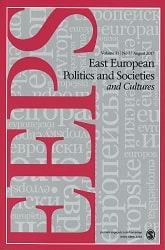Claiming the Shipyard, the Cowboy Hat, and the Anchor for Women: Polish Feminism’s Dialogue and Struggle with National Symbolism
Claiming the Shipyard, the Cowboy Hat, and the Anchor for Women: Polish Feminism’s Dialogue and Struggle with National Symbolism
Author(s): Agnieszka GraffSubject(s): Gender Studies, Social Philosophy, Civil Society, History of ideas, Gender history, Nationalism Studies, Transformation Period (1990 - 2010), Rhetoric
Published by: SAGE Publications Ltd
Keywords: feminism; nationalism; symbols; contestation; Poland;
Summary/Abstract: This article examines the evolving role of national symbolism in Polish feminist discourses and activist practices since 1989. Three case studies involving symbolic appropriation are presented; in each, cultural signs of great importance to the national imaginary are put to work for women’s equality in acts of resistance to nationalist rhetoric. The first case is the graffiti reportedly seen on the wall of the Gdańsk Shipyard during the 1980 Solidarity strike: “Women, do not disturb us, we are fighting for Poland.” The sign and the story behind it came to play an important role in feminist debates about national belonging and exclusion. The second example is the 1989 election poster featuring Gary Cooper, twice transformed by feminists. Finally, the article examines the struggle between nationalists and feminists over the “fighting Poland” sign associated with the Warsaw Uprising of 1944. The Black Protest of 2016 creatively transformed this symbol, which led to much public debate and several court cases. This article argues that Polish feminism is engaged in contestation of the dominant understanding of nationhood imposed by right-wing, male-centered forces and the Catholic Church. Responses to the post-1989 resurgence of nationalism have constituted key dividing lines between strands of feminist activism and thinking in Poland. The two competing strategies have been pathos and irony. The Black Protest seems to mark a new stage in these developments—one that corresponds to Victor Turner’s communitas, with its characteristic turmoil and symbolic intensity.
Journal: East European Politics and Societies
- Issue Year: 33/2019
- Issue No: 02
- Page Range: 472-496
- Page Count: 25
- Language: English
- Content File-PDF

